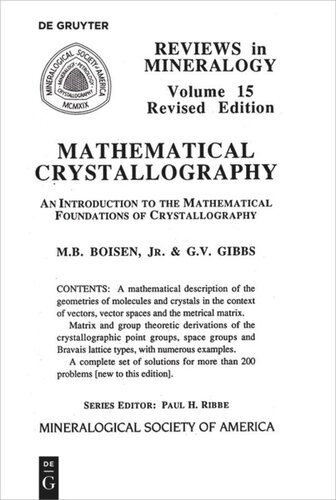

Most ebook files are in PDF format, so you can easily read them using various software such as Foxit Reader or directly on the Google Chrome browser.
Some ebook files are released by publishers in other formats such as .awz, .mobi, .epub, .fb2, etc. You may need to install specific software to read these formats on mobile/PC, such as Calibre.
Please read the tutorial at this link: https://ebookbell.com/faq
We offer FREE conversion to the popular formats you request; however, this may take some time. Therefore, right after payment, please email us, and we will try to provide the service as quickly as possible.
For some exceptional file formats or broken links (if any), please refrain from opening any disputes. Instead, email us first, and we will try to assist within a maximum of 6 hours.
EbookBell Team

4.3
78 reviewsVolume 15 of Reviews in Mineralogy is written with two goals in mind. The first is to derive the 32 crystallographic point groups, the 14 Bravais lattice types and the 230 crystallographic space group types. The second is to develop the mathematical tools necessary for these derivations in such a manner as to lay the mathematical foundation needed to solve numerous basic problems in crystallography and to avoid extraneous discourses. To demonstrate how these tools can be employed, a large number of examples are solved and problems are given. The book is, by and large, self-contained. In particular, topics usually omitted from the traditional courses in mathematics that are essential to the study of crystallography are discussed. For example, the techniques needed to work in vector spaces with noncartesian bases are developed. Unlike the traditional group-theoretical approach, isomorphism is not the essential ingredient in crystallographic classification schemes. Because alternative classification schemes must be used, the notions of equivalence relations and classes which are fundamental to such schemes are defined, discussed and illustrated. For example, we will find that the classification of the crystallographic space groups into the traditional 230 types is defined in terms of their matrix representations. Therefore, the derivation of these groups from the point groups will be conducted using the 37 distinct matrix groups rather than the 32 point groups they represent.